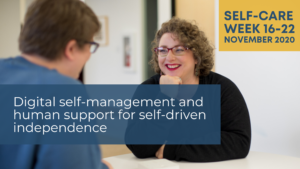Self Care Week: Digital self-management support for improved mental health and wellbeing
Posted: 20th November 2020
 For the final day of our Self Care Week campaign, we are continuing to profile some of the companies we’re working with who have innovative services and products that help people live more independently and manage their conditions themselves. In this article, we look at Brain in Hand which provides digital tools to support people with mental health challenges.
For the final day of our Self Care Week campaign, we are continuing to profile some of the companies we’re working with who have innovative services and products that help people live more independently and manage their conditions themselves. In this article, we look at Brain in Hand which provides digital tools to support people with mental health challenges.
As we’ve seen throughout the COVID-19 pandemic, the need for digitally delivered support of all kinds has accelerated. The widespread use of video conferencing platforms and other virtual technologies enables us to reach more people in need, support our loved ones, and stay connected.
Brain in Hand is a digital self-management system combining specialist human support and technology to help people live more independent lives. Designed for people with mental health challenges including autistic people, those with learning difficulties, and those who are neurodivergent, it helps people achieve more with less support.
Brain in Hand provides an integrated self-support system that includes:
- One-to-One Specialist Support – A qualified Brain in Hand Specialist supports each user to identify goals, recognise strengths, and develop solutions to overcome problems. Our team supports each user to get started in the right way and stays in touch to ensure the system remains optimised for their unique needs.
- Web and mobile software – A suite of self-management tools, personalised on a secure web page and accessed through a phone or smart device, helps with managing anxiety, remembering things, planning, making decisions, and unplanned events.
- Round-the-Clock Support – Whenever the user needs some extra support, they can use a simple traffic light system to alert a responder to get in touch with them. This could be a specialist responder or a member of their existing support network.
Brain in Hand is a proven technology that eases the burden on services to provide personalised, user-led care and support. It has transformed the lives of 10,000 users to date and is in use by 30% of English local authorities, 80% of universities and a growing number of NHS provider sites. It is also funded out of Department for Education and the Department for Work and Pensions.
Helping people to achieve more
Brain in Hand is used in Kirklees as part of The Working Together Better partnership of commissioned mental health services. It is located within the Community Links Engagement and Recovery (CLEAR) service, a non-profit provider commissioned to deliver support to around 500 adults with mental health needs each year. Brain in Hand is also used at Kirklees College to help improve resilience.
A Brain in Hand coordinator receives referrals and establishes whether Brain in Hand is the appropriate approach, and then works with the individual to identify goals and solutions that they want to achieve. Brain in Hand users have achieved all kinds of incredible goals including using public transport; managing anxiety; improved problem solving; increased confidence; successful transition into employment and ultimately increased independence.
Hannalease Newton, a Brain in Hand co-ordinator says:
“One individual had concerns about managing her wellbeing during the COVID pandemic. She has used Brain in Hand to support accessing an online arts and crafts group that has built her confidence and established supportive relationships”
A Brain in Hand user said:
“Before Brain in Hand, I could not have worked, and I would not have been able to cope with everything. I do not think I would be in the situation I am in going into work every day.”
Take-Away Tips for using Brain in Hand
- Identify the goals the users want to achieve and the barriers in the way. Use this to co-produce solutions and strategies to include into the Brain in Hand system.
- Celebrate early wins with the user and the service, communicate these widely to demonstrate the power that digital technology can make to improve user outcomes and reduce the burden on services.
- Ensure both clinical and operational teams are included in the discussion about where and how to integrate Brain in Hand into existing care pathways early on. Identify an organisation sponsor or champion.
- Brain in Hand is recommended for young people and adults who experience anxiety, have difficulty managing their behaviour or struggle to remember things. The system helps to identify the early signs of an anxious episode so that strategies can be implemented before it becomes overwhelming.
- Start thinking about the evaluation metrics of the system at the start of the programme. Work with the Brain in Hand programme manager to develop measurement criteria from the outset to ensure repeat commissioning in year 2. These metrics can be both qualitative and quantitative.
Yorkshire & Humber AHSN have been working with Brain in Hand to raise awareness of the innovation across the region, provide the company with a platform at events connecting innovative solutions with mental health commissioners and practitioners.
Find out more about Brain in Hand
Read about the cost savings and impact of Brain in Hand in Kirklees
